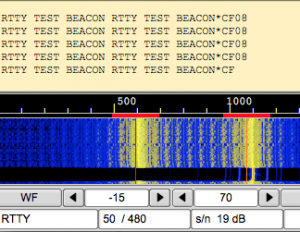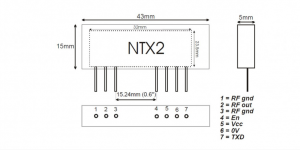A circuit from the UK High Altitude Balloon sight, that sends RTTY, from Arduino using the Radiometrix NTX2 transmitter on 434.650 Mhz.
http://ukhas.org.uk/guides:linkingarduinotontx2#where_to_buy_the_ntx2
circuit notes
substituted 2 100k resistors in parallel for the 47k connected to TX output in the circuit
RTTY settings
We used rtl-sdr with Max as the receiver, in SSB mode, sending audio via Soundcloud to dl-fldigi to decode the RTTY. The params that worked:
- 50 baud
- carrier shift 400-480 hz (varies)
- 7 bits per char
- no parity
- 2 stop bits
- reverse mode on
audio input monitor in dl-fldigi
Unfortunately there was no way to hear the signal while decoding because dl-fldigi doesn’t feed through the input audio. A workaround is to run Audacity in the background. In audacity:
- set input to soundflower,
- set output to built-in output
- press pause
- press record – now you should hear the radio.
pwm circuit
An updated version of the system described above.
This circuit features no additional components. Just the NTX2 and Arduino. The voltages are generated using PWM (pulse width modulation).
Described in a 3 part series.
by Anthony Stirk at ava.upuaut.net
Example 1 – testing
The first example generates a carrier shift of 310 Hz. It took several minutes for the transmit frequency to stop drifting. The AFC setting in dl-fldigi helps to keep things locked in – as long as their is a constant carrier.
Example 2 – RTTY
Reducing the filter bandwidth to less than 150 Hz helps, due to the narrow carrier shift.
Example 3 – dominoEX MFSK
Requires a 175 ohm resistor for precise timing. Didn’t have one, so I just ran the sketch without decoding. Here’s what it sounds like:
what’s next?
- decoding RTTY in Max



